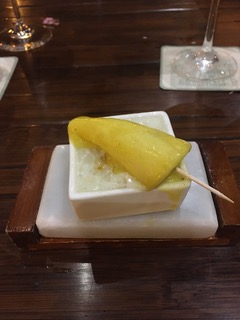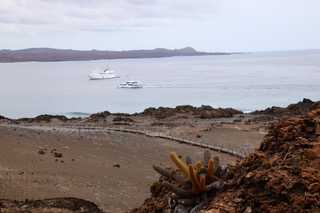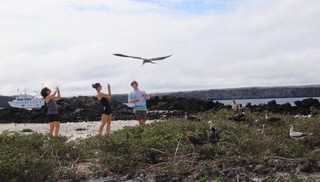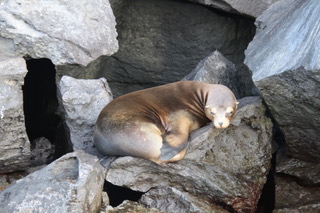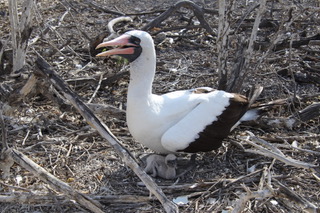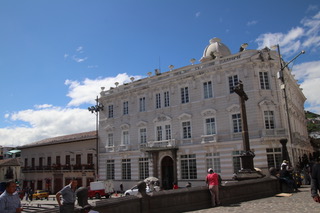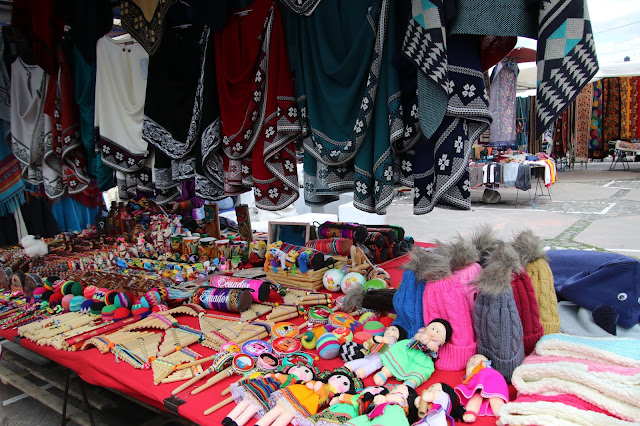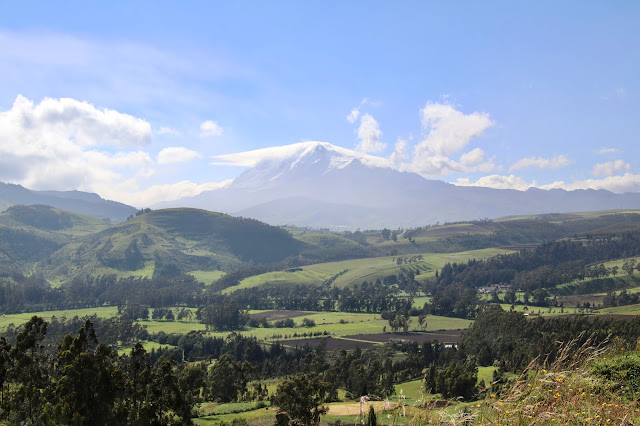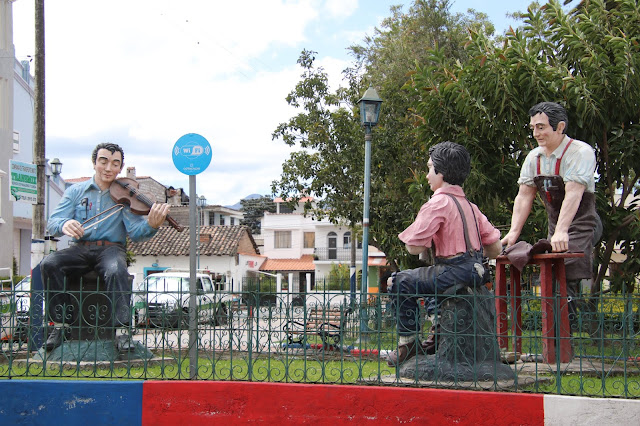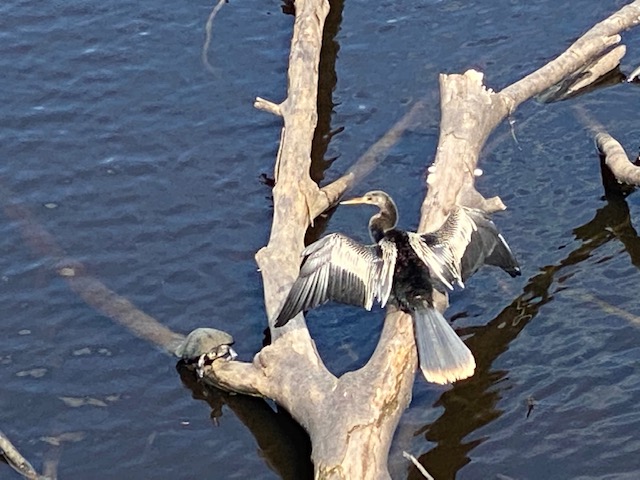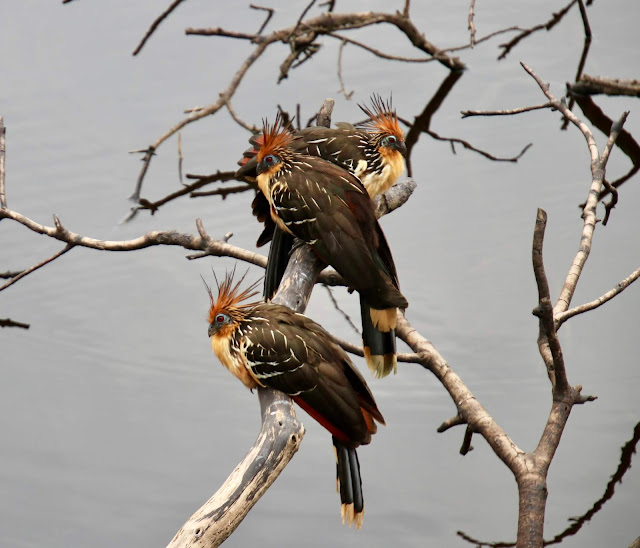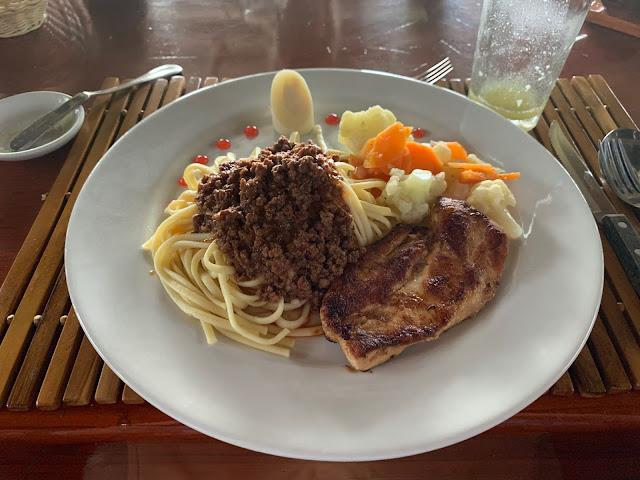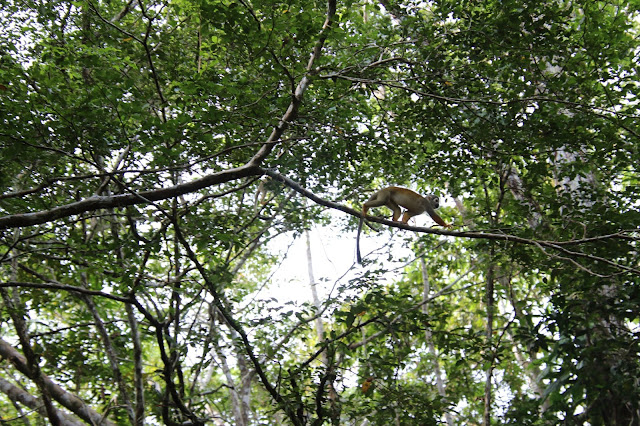Saturday, January 4. After a long day's travel through Miami, we arrived in the evening in Ecuador's largest city (3.5 million) and commercial hub, Guayaquil. A short ride brought us to the Hotel del Parque, our home for two nights. The hotel is housed within the former Hospice of the Heart of Jesus, a beautiful wooden heritage building dating back to 1892, that was moved board-by-board to its present location in Guayaquil's Central Historical Park, and fully restored in a four-year effort establishing it as Guayaquil's first luxury boutique (31 rooms) hotel.
The juxtaposition of classic architecture and furnishings with contemporary art here in the lobby and throughout the Hotel del Parque is striking and elegant.
The do-it-yourself limonada imperial fixins' and chocolate truffles were a welcome find in our room after a long travel day!
Sunday, January 5. On our free day, we took the opportunity to enjoy breakfast in one of the hotel's beautiful interior courtyards and lounge a bit in this one.
We also explored the Central Historical Park surrounding the hotel. A small zoo contained a number of native birds and mammals we would see elsewhere in mainland Ecuador, and two we would not. The first was this Ocelot. Smaller than the jaguar and puma that are also found in mainland Ecuador, ocelots inhabit both dry forests and rain forests. They are nocturnal and solitary (and thus rarely seen), pairing only to mate.
The other species we only saw here is the Crab-eating Raccoon. Its four paws have 5 long digits, with the forepaws being very agile, almost like hands. They are very intelligent, gregarious and nocturnal, with excellent vision. They prey mostly on crabs but also feed on invertebrates, crustaceans, insects, nuts, vegetables, fish, frogs and small turtles. The two we saw here were playing nonstop and very aggressively ... really sharp teeth!
The Central Historical Park had several other very nice exhibits and activities pertaining to Ecuadorian history, culture and modern life. As Ecuador is one of the primary sources of chocolate for world markets, we chose to learn about it. Using beans from cacao pods like these grown on-site, a guide showed us step-by-step how chocolate is made using traditional methods.
Generally speaking, most varieties of cacao are considered ripe when they start to turn yellow.
The seeds (also called beans) are extracted from the pods, fermented and then set aside to dry.
Once dried, the beans are pan-roasted.
Then, after careful inspection to discard any that are overdone, the beans are hulled to produce the nibs, which are then ground and from which finished chocolates are made.
We sampled varying "strengths" of chocolate, from 60% (a good, dark milk chocolate) to 100% (very bitter). We also learned that "white chocolate" is really not chocolate at all, but fats in the cocoa bean ("cocoa butter") that are pressed out after the beans are roasted and mixed with cream and sugar. Ecuadoreans claim they produce the best chocolate in the world, and after consuming plenty of it, we can't disagree.
Casa Julian, the Hotel del Parque's restaurant, was the 200-year-old family home of renowned surgeon Doctor Julian Coronel. After a relaxing afternoon in and around the park, we had dinner there.
We started at the bar, for delightful complimentary welcome cocktails, served with thin, crispy and addicting plantain and sweet potato chips.
Cafe Julian bases its menu on the freshest local ingredients and dishes inspired by Guayaquil traditions. We had no idea what those might be, so we opted for the 6-course tasting menu, which pays homage to neighborhoods in Guayaquil. To get a sense of what high-end Ecuadorian cuisine is, here's a look at each course. First, recognizing the city's "El Centro," was La Palma ... a soft-boiled egg, truffled country sausage and a puff crisp.
Los Shawarmas represented the "Ardeza" district ... Ahi Tuna Kibbeh Nayeh, roasted garlic, yogurt and zataar.
Next, on behalf of the "9 de Octobre" neighborhood, Yulan included Boulin noir (blood sausage), Stone Crab and ripe plantain, with spearmint and pickled apples.
For the last main course, Pollos el Encanto represented the "Saucez" district ... Roasted Chicken, rillete, Melissa and parmanito bean Minestra, and a rice crackling.
For the first dessert, representing the whole city, we had Helado (Ice Cream) ... a rice and milk pudding, with lemongrass and Lulu fruit sorbet.
And to wrap it up, on behalf of the "Centro Sui" area, we enjoyed this Mr. Palma ... Coconut "Panetela," dark cocada with parmesan, coconut ice cream and chocolate sauce. The white chocolate "sculpture" in the foreground represents the skyline of Guayaquil. With a very good Ecuadorian sauvignon blanc, we thoroughly enjoyed every course of this first adventure in a very interesting and creative dining scene. A great end to our day of rest in Guayaquil!
Monday, January 6. After breakfast, we returned to the Guayaquil airport for our two-hour flight to Baltra, one of two airports in the Galapagos islands. The Galapagos ... about 600 miles off the Ecuadorian coast ... are pretty much entirely a national park; access is limited, and entrance and activity are strictly controlled. After a short bus ride away from the airport, we took a short ferry ride across the Itabaca Channel to the north shore of Santa Cruz Island. We took a bus through several zones of vegetation up to the highlands (about 1500 feet above sea level), where our first stop was a local restaurant for lunch.
After lunch, we continued on the bus to a reserve that is one of the best places in the entire Galapagos archipelago to see the Galapagos Giant Tortoise in its native habitat. As you can see, this reserve was definitely off the digital grid!
We did not realize that the prime habitat for the Galapagos Giant Tortoise is the wooded highlands rather than the rocky/sandy coasts and beaches. It was quite amazing to see them roaming freely (albeit really slowly) among cattle and sheep in pastures and grazing lands.
This is perfect habitat, because they eat more than 30 varieties of the vegetation that literally surrounds them ... as you can see from their size, adequate food is definitely not an issue!
A face that perhaps only a mother could love!
The only naturally-occurring freshwater in the entire Galapagos archipelago is found where rainwater collects in potholes and small ponds like this one. The tortoises gather here in large numbers, but it's all about the water ... not any social instinct or interaction. To be sure, other members of our group did observe mating activity that modesty precludes showing here.
After our fascinating visit with the Galapagos Giant Tortoises, we made our way to the small, charming port village of Puerto Ayora and ferried out in Zodiacs to the yacht La Pinta ... our home for the next three days of cruising the northern Galapagos. Its 24 cabins hold a total of 48 guests, with solid, if unspectacular food but a very good bartender. Overall, it was quite comfortable.
Tuesday, January 7. The Ecuadoreans call the Zodiacs pangas. After breakfast, we took a panga to and along the shore of Eden Islet, just off the coast of Santa Cruz. We didn't have to wait long or look hard to see teeming wildlife ...
Blue-footed Boobies were the most interesting and prominent birds we saw this morning ... the first of three distinct species of boobies we would encounter. Blue-footed Boobies range along the Pacific Coast from Mexico to Peru, but about half of this non-threatened species live in the Galapagos. The males perform a mating dance in which they show off their feet in up-and-down movements to attract females. Apparently, it'a all about the color, as a more turquoise shade is more attractive to females than a deep blue ... The shade of blue is linked to the amount of food the male consumes, and thus an indicator of how good a provider he is likely to be. These boobies fish in spectacular plunge-type dives, often chasing fish while underwater. They can be up to 3 feet long, with a wingspan of up to almost 5 feet ... big birds!
As we got close to the rocky coast, we noticed what came to be incredible numbers of Sally Lightfoot crabs on the rocks. We'd see these basically everywhere we went in the Galapagos.
On closer inspection, the crabs were incredibly colorful ... overall orange-reddish, but with any number of shades of yellow and blue as well in their shells.
We also soon encountered our first Marine Iguanas, endemic to the Galapagos and dubbed "imps of darkness" by Charles Darwin. They arrived in the Galapagos as standard land iguanas, but evolved into their unique marine status before spreading throughout the archipelago. They are found on all the Galapagos islands, but vary in size and color significantly from island to island, with several subspecies. Their critical adaptations to their marine habitat include a reduced heartbeat and constriction of blood vessels near the skin, to avoid temperature and oxygen loss when exposed to colder ocean currents. A shortened snout with small tricuspid teeth allows them to graze on the narrow algae they forage at low tide either submerged -- especially in the case of larger iguanas -- or exposed by low tide -- favored by smaller ones. Marine Iguanas also have a supersized supraorbital gland, which acts like a kidney to extract excess salt from their blood, allowing them to sneeze it out several times a day (marine birds also have this adaptation). These two males -- each about 3 feet long -- were engaged in a pushing contest ... not suprisingly, over the affections of a female sitting and watching about 10 feet to the right. This went on for 10-15 minutes -- we didn't stay to see who won!
This photo gives perhaps a better view of the Marine Iguana ... colors varied according to age (which can be up to 40 years), as well as the island/subspecies.
If you look closely, you can see 2 bird species, Marine Iguanas and crabs all in this one photo. We observed such a remarkable variety and quantity of wildlife, sharing space at very close quarters and seemingly oblivious to one another, repeatedly throughout our explorations ... one of the unique attributes of the Galapagos.
Just before our panga headed back to La Pinta for lunch, we encountered this solitary Galapagos Sea Lion in the shallows. This is the smallest species of sea lion. Since it lives on the equator and is thus exposed to greater heat and potentially less food than its colder-climate cousins, its size may be an adaptation since its ancestors apparently reached the Galapagos about 1.2 million years ago. There are currently about 20,000 Galapagos Sea Lions distributed and well-protected throughout the archipelago; however, since it is an endemic species in such a small area, it is listed as endangered.
After lunch, we headed off in the panga to the tiny island of Sombrero Chino, named for its perceived resemblance to a Chinese hat (go figure). Sombrero Chino is a "spatter cone" formed by materials ejected from an ages-old volcanic eruption on nearby Santiago Island, and has a number of unrelated lava flows of more recent vintage as well.
As we approached the shore, we saw our first Galapagos Brown Pelican. A subspecies of pelican endemic to the Galapagos, adults like this one average about 3 1/2 feet in length and have a wingspan of over 7 feet ... big birds. They plunge-dive for fish with their beak wide open and wings fully extended, trapping several gallons of water along with (hopefully) the target fish in their gular sac under the beak. They then have to expel the water without losing the fish ... it's all pretty awkward, but they seem to make it work.
Next, we passed our first Galapagos Penguin. Also endemic to the Galapagos, this is the smallest species of warm-water penguin in the world, and the only one that lives anywhere near the Equator. The cold-water Humboldt and Cromwell currents passing nearby enable it to survive in the Galapagos, and it suffers when those currents are adversely affected by El Nino weather patterns.
We were really fortunate to get this decent photo of a nesting Galapagos Hawk, from much farther away than it looks. Also endemic, and with less than 150 mating pairs known to exist, it is uncommon to see one at all, and much more likely to see one in flight than on a nest. Galapagos Hawks are the top of the air-land food chain, preying on lizards, snakes, tortoise and sea turtle hatchlings, other birds eggs and chicks, and rodents as well as scavenging. They can grow to be 2 to 2 1/2 feet long, with a wingspan of up to 4-5 feet.
As we approached our landing spot, we noticed the beginnings of sparse vegetation on the otherwise bleak and forbidding volcanic landscape.
We made our first "wet landing" from the panga (in about 6 inches of water!) on this crescent-shaped white, sandy beach. After changing to dry footwear, our naturalist guide led us along a 400-yard trail along the shore.
The island scenery itself was stunning, and certainly conveyed just how rugged and remote these little volcanic islands are.
Very soon, we happened upon a number of Galapagos Sea Lions sunning on the beach ... including this incredibly cute and curious infant pup -- only 1 or 2 days old -- with its resting mom.
As we all clustered to get photos of the pup, Dad kept a close eye on things from the edge of the surf just feet away. Like virtually every animal we saw or encountered in the Galapagos, they had no fear and, apart from an occasional curious look, seemed to take no real account of us at all. Just amazing!
Nearby, the ubiquitous Sally Lightfoot Crabs were scrambling around all over the rocks.
These crabs are not endemic to the Galapagos, and can be found all along the Pacific coast of Central and South America. Juveniles are black or dark brown in color, but adults display all sorts of colors. They are not considered particularly edible by humans, but are used by fisherman as bait.
A bit further on, we saw a Small Ground Finch --our first Darwin's Finch. Famous for their place in Darwin's thinking about evolution, there are actually 14 species of Darwin's Finches ... 13 of which are endemic to various of the Galapagos islands (the other species is endemic to the Coco Islands, also isolated in the eastern Pacific Ocean). They are actually not finches at all, but members of the tanager family. In a nutshell, it is believed their common ancestor -- the Dull-Coloured Grossquit -- arrived in the Galapagos from South America. From there, the 13 species evolved as adaptations to local conditions on the different islands ... a key case presented for the theory of evolution in Darwin's Origin of the Species.
No chronicle of a nature trip would be complete without animals caught, as a lawyer might say, in flagrante delicto, and the Marine Iguanas did not disappoint. This went on for at least 10 minutes ... please note which party is smiling, and which looks bored.
Tearing ourselves away finally from the iguanas, we also noticed this much smaller Lava Lizard.
As headed back to the beach, we got this firsthand view of why they are named Marine Iguanas!
As our panga pulled away from Sombrero Chino to return to the ship, these Galapagos Penguins bade us farewell at the end of a fascinating and enjoyable first day in these unique islands!
Wednesday, January 8. Bartolome Island is one of the iconic stops in the northern Galapagos. After breakfast, we boarded our panga for a run around Pinnacle Rock to a landing and a steep climb up a wooden staircase and boardwalk to Bartolome's highest point.
As we neared the landing point, we were greeted by this solitary Galapagos Penguin ...
... who was SO excited to see us.
We also saw our first Galapagos Lava Heron. The Lava Heron, a variety of Striated Heron, is endemic to the Galapagos, and its adaptation is chiefly in its coloring, which blends into the dark lava and enables it to hide from predators. Among other things, the Lava Heron eats crabs ... as many as 2-3 per minute. According to experts, the Lava Heron is so tame it will let you take its photo from as close as 8 inches ... we didn't quite test that, but it certainly was indifferent as we motored past.
We made a dry landing at the foot of this boardwalk, and headed off and up toward the peak.
The views along the shore back toward Pinnacle Rock as we ascended were spectacular.
We also noted the early signs of vegetation emerging from the seemingly lifeless lava and volcanic rock, and this grasshopper ...
... as well as this Lava Lizard.
As you can see, it was quite a climb from the beach ...
... quite a climb, indeed! Note the interesting cactus in the foreground ... one of the early forms of vegetation that emerge in this volcanic terrain.
After the best part of an hour, we reached the top and a great view.
Note the much larger amount and variety of vegetation down by the beach, where there's much more soil.
As always, what goes up must come down ... so we retraced our steps ...
... and re-boarded our panga, for the run back to La Pinta and lunch.
Our afternoon excursion to Sullivan Bay on Santiago Island was all about the volcanic origins of the Galapagos, and lava. We hiked across a lava field less than 100 years old, staying between the white markers to avoid breaking through the lava'a top crust in areas where there are tubes, holes and hollows.
Interestingly, but perhaps not surprisingly, two of the four discrete types of lava have Hawaiian names. This is pahoehoe (puh-hoy-hoy) lava. It had a very low viscosity when molten, and flowed smoothly and cooled with a "ropy" surface texture.
Even in such a seemingly desolate environment, with no real soil, little rain and no other source of fresh water, after 100 years life does start to emerge.
This is A'a (ah-ah) lava. This lava is not safe for walking because the upper crust is made up of loose blocks that are not stable ... you can see how these slabs have cracked and broken since the flow.
The path and extent of the most recent flows was very easy to see.
At least 20-30 feet tall, this endemic tree is actually the world's largest species of dandelion! We first saw these in the forested highlands on Santa Cruz on the day we arrived, and it was striking to see another here in the midst of the lava fields.
Finally, we reached the end of the lava flow ... it's fascinating to think that, in theory at least, we might have stood here 100 years ago and watched as this incredible force of nature slowly stopped right in front of us.
Just beyond the edge of the flow, a single cactus sprouted up from the arid landscape ...
... and even in the flow itself, a sizable lava cactus has already emerged.
Finally, we reached the far side of Santiago, and rode the panga back to the ship after learning a lot about how these islands were formed and evolve even today.
Thursday, January 9. In the morning, we took the panga to explore the bird colonies at Darwin Bay on the island of Genovesa. After a dry landing, we immediately ran across this adorable Nazca Booby chick standing by the trail. It needs to grow into its feet a little bit, don't you think?
Very soon, we came across our first Red-Footed Boobies -- lots of them. These boobies dive vertically into the water, and can dive down up to 90 feet in search of their preferred prey of squid and flying fish. They are not endemic to the Galapagos, but Genovesa in particular has large colonies of them. They are the smallest booby species, but still large, at up to 2 1/4 feet long, with a wingspan of up to 4 feet.
This is a Yellow-Crowned Night Heron. It feeds at night, but during daylight, it frequently makes appearances in shady spots along the shore, as here. It can be up to 2 feet long, with a wingspan of almost 4 feet. It is capable of extending its neck considerably, to achieve a more classic heron profile.
As we proceeded, we encountered this Galapagos Brown Pelican ...
... and got our first look at these Galapagos Swallow-Tailed Gulls. These are endemic to the Galapagos, and the only fully nocturnal gull in the world. Not a diver, it feeds miles from shore on fish and squid it captures from the ocean's surface.
A female Great Frigate. Great and Magnificent Frigates have the largest wingspan to body ratio of any seabirds -- their wingspan can exceed 8 feet -- and can stay aloft for a week or more at sea. They do not dive or swim, and either catch prey like flying fish in the air above the surface, or rob other birds of their catch by interdicting and shaking them in mid-air. Frigates seen in the air over land or near shore are usually Greats, as Magnificent Frigates usually hunt farther out to sea.
Red-footed Boobies can be either White Morph or Brown Morph. This Brown Morph is slightly more common.
We came soon to an open area where hundreds of birds of several varieties were nesting.
As they took off, we could appreciate just how big they were!
Above us, a Great Frigate soared majestically. We saw them constantly, but capturing a decent photo in flight was a challenge. They reminded us of the pterodactyl -- the flying dinosaur.
In nearby rocks, we spotted this Medium Ground Finch, another of the endemic Darwin's Finch species.
As we got back to our landing spot at the beach, a juvenile Brown Pelican was greeting our fellow travelers who had gone snorkeling.
From there, we went sea kayaking off the coast before returning to the ship for lunch. Great fun!
After lunch, we took the panga back to Genovesa. As we approached the coast, we saw a number of what appeared to be Galapagos Sea Lions sleeping among the rocks.
On closer approach, at least one actually turned out to be a Galapagos Fur Seal. This endemic species is the world's smallest seal, with females averaging around 66 pounds, and males 176 pounds. Galapagos Fur Seals are nocturnal; they tend to hunt well offshore at depths of 200-330 feet, seeking fish and squid that tend to rise at night from further below. But when the moon is near full, they don't rise, and so the seals tend to stay on land during those bright nights.
The Fur Seal's appearance was easy to differentiate from this Galapagos Sea Lion lounging only a few feet away.
We made a dry landing (after shooing a Galapagos Sea Lion off the landing platform!) at Prince Philip's Steps, and ascended about 100 feet up onto a plain that was filled with nesting birds ... largely Nazca Boobies. In a very small area, we were able to see them ...
... sitting on an egg ...
... guarding and shielding a newly-hatched chick from the sun ...
... and raising a very-quickly growing juvenile toward first flight and independence. Nazcas are the largest booby present in the Galapagos, and the most violently competitive Darwinist among them all. Females lay 2 eggs, 4 to 5 days apart, so that if the first is broken or eaten, the second may yet produce an offspring. That said, if both hatch, hatchlings regularly commit siblicide by pushing the smaller brother or sister out of the nest, without the parents taking any action. They are considered non-threatened, although their global population is thought to be declining.
Beyond the Nazcas, we spotted this male Magnificent Frigate. Male Magnificent Frigates inflate their red gullar sacks to attract females ... it can take half an hour for the sack to inflate fully to be a bright red, heart-shaped balloon. To attract females, males inflate their red sacs and squawk to attract females flying overhead. When a female makes a selection, she flies down and perches next to the male, who spreads his huge wings around her to claim and protect her from competition ... very traditional birds!
We emerged from the scrub to a lava-covered area with deep volcanic crevices, searching for a particular, rare bird known to inhabit them.
But first, we saw another Yellow-Crowned Night Heron ...
... and what do you know ... the first pretty flower we'd seen in quite a while!
Friday, January 10. After an early breakfast, we said goodbye to La Pinta and flew east from Baltra to the mainland and Quito, the capital of Ecuador. From the airport, our guide and driver took us to our overnight stop at Casa Gangotene, a beautifully restored hotel on a large square in the central Historical District.
In our room, we found a display of exotic Ecuadorian fresh fruits. Clockwise from the top right, we have (1) an Orito (baby banana) and a Granadilla (more on this below); (2) Uvilla (like a gooseberry ... an Andean fruit with a unique sweet and tart taste); (3) Tomate de Arbol (tree tomatoes ... bittersweet, like a combination of berries and grapefruit; and (4) we don't know what these are.
We sampled the Granadilla. You crack it like an egg, and scoop out the pulp and seeds inside. The trick is to taste the pulp, which is soft and sweet, without chewing the seeds. The taste was delicious ... while the texture was, shall we say, unique. In any event, all part of the adventure!
Casa Gangotena's dining room is considered among the top kitchens in Quito, and we were happy to enjoy its tasting menu of Ecuadorian specialties after a long travel day. We started with this simple but tasty vegetable amuse.
The first course was an Ecuadorian Pacific Oyster with Bloody Mary pearls, citrus foam and cilantro salt. But not being oyster people, we substituted this delicious trio of empanadas -- shrimp, plantain and yucca.
Next up, the Manabi Fish Ceviche ... catch of the day, lemon and peanut bouillon, avocado and cucumber.
Garlic Langoustine ... garlic foam, cassava and neapia, macambo.
Potato Pork ... roast potato, fried pork rind, peanut sauce.
Pork a la Beer ... pork shoulder, whole cane sugar and beer, rustic mashed potatoes.
Pistachio Lamb (our favorite!) ... pistachio-crusted lamb, sweet potato and ginger, rosemary and sage.
And to finish ... Amazonian Essence ... tangerine and guayusa sorbet, sacha inchi biscuit, candied macambo. Another exotic, excellent meal.
After dinner, we went up to the rooftop terrace to admire Quito's historic center by night. This photo captures the lighted Church and Monastery of San Francisco, a 16th-century complex on the Plaza de San Francisco directly in front of our hotel. It is the oldest and most significant religious site in Ecuador. Great views to end the day!
Saturday, January 11. At breakfast, Pam had the best camomile tea ever ... made with fresh camomile leaves rather than dried. We've never seen that before.
After breakfast, our guide and driver took us on a quick tour of highlights in Quito. First, we drove to a scenic overlook ...
... and got these great views across the capital city of 2.5 million.
This 100-foot tall aluminum statue of Our Lady looks out over it all.
Returning to the Plaza de San Francisco in front of our hotel in the historic district, we struck out on foot to catch some quick highlights of this UNESCO World Heritage site.
First stop was the Courtyard of the Convent of San Francisco. It is beautifully maintained, with some original 15th-century frescoes still visible on the walls in the cloisters.
We climbed the stairs to the choir loft inside the adjacent Church, as a Mass was underway in the sanctuary below. We were surprised and delighted to find we were sharing the loft with a Franciscan monk, who was playing the massive pipe organ and singing the hymns of the liturgy in a very fine tenor. As the photo shows, the sanctuary is ornate and beautiful.
We emerged into the Plaza de San Francisco ...
... and immediately noticed this group of folk dancers.
We could not tell whether they were members of a particular indigenous group, or just a happy dance group ...
... but they certainly had eccentric and colorful costumes, and energetic moves!
We walked up this street toward the white bell tower on the right side, there to visit the spectacular temple of La Compania de Jesus (the Jesuits) and its awesome gilded interior. Many consider it one of the most beautiful churches in South America, perhaps even the world. We would be hard-pressed to disagree, but you'll have to Google it to form your own judgment, as photographs are not allowed.
From there we entered Independence Plaza, which is flanked by the Cathedral, the Presidential Palace, the Municipal Building and the Archbishop's Palace. This statue in the middle of the beautifully landscaped square commemorates Ecuador's independence from Spain in 1809, part of the South American liberation movement led by Simon Bolivar.
From here, we hit the road toward Otavalo. On our way out of Quito, we passed lots of this colorful and creative street art.
After a two-hour journey, we reached Hacienda Zuleta in the Andean Highlands north of Quito ... our home for the next three nights.
Hacienda Zuleta is a stunning 17th-century hotel and working farm high in the Andes (9,600 feet), that was the family home of former Ecuador President Galo Plaza Lasso and remains in the family to this day. This two-story hall filled with family treasures and memorabilia was the "living room" for our quarters ... which were just through and around the corner from the doorway at the top of the stairs. Immediately to the left of the doorway are portraits of Galo Lasso and his father, who was also Ecuador's President at the turn of the 20th century.
Our sunny and spacious bedroom, one of 14 on the property ...
... had this beautiful view over a portion of the 4,000-acre farm to the surrounding peaks.
After dropping our bags, we had a late lunch in this beautiful dining room.
Quinoa Soup with Matchstick Potatoes ... yummy!
Followed by superb fresh trout from one of the many streams flowing through the property. The cheeses on the table are also made at the Hacienda ... more on that shortly. After unpacking and settling in, we met some fellow guests over dinner and retired early after a long day.
Sunday, January 12. After breakfast, our guide and driver picked us up for a tour to some villages in the Andean Highlands noted for indigenous crafts. On this beautiful morning, we stopped for this photo in front of Lago San Pablo, the largest lake in this region.
In the village of Agato, we visited the Tahuantinsuyo Weaving Workshop. Here, 86-year-old master weaver Miguel Andrango and his family use traditional handmade backstrap loom weaving techniques of the Ecuadorian Andes to produce beautiful textiles and garments.
With translation provided by our guide, Miguel's grand-daughter gave us a full demonstration of how the family works, from freshly-sheared raw materials to the finished product. She is wearing the traditional clothing of her indigenous group ... not a costume, but her everyday wear.
After cleaning, carding and preparing the fibers, she demonstrated the "old" method they used to spin them into thread. This required constantly turning the needle/spindle in her right hand, in order to "spin" the thread ... what our tradition would have done with a spinning wheel. One can only imagine how slow and hard this must have been, not to mention the risk of repetitive motion trauma to the wrist over time.
Then she demonstrated the "new" method they use now, with a hand-powered machine that the family invented. As she pulls on the line with her right hand, the spindle at the far end spins quite fast ... this is a much easier, faster and more efficient technique. And it certainly still qualifies as hand-made!
Not surprisingly, they only use natural dyes that are collected from the local area.
Her son Eduardo joined us, and demonstrated the backstrap loom ... named, of course, for the strap that goes around the operator's back to stretch the loom.
It was fascinating to watch Eduardo work at close range. In response to Pam's question, he purposely made a mistake in the weave and showed us how, and how quickly, he could correct it. Eduardo's mother said each family member can complete, on average, 6-7 finished products a YEAR.
After the demonstration, we visited the workshop's small sales room and Pam found a beautiful alpaca jacket. Fortunately, the only size was the perfect size ... clearly a sign that she was meant to have it!
We next visited another family workshop devoted to traditional musical instruments. They ranged from long horns like this one, used to communicate from village to village through the Andes ...
... to the many varieties of pan flutes played by different indigenous groups of the mountain regions throughout South America, as well as string and percussion instruments. We enjoyed this little concert, and the opportunity to admire the craftsmanship.
Next, we visited an open-air fruit and vegetable market. The variety and quality of the produce was amazing, including any number of fruits and vegetables new to us. The sold quantity, generally speaking, is "X U.S. dollars' worth," and it's hard to believe how much you get for $1. If the produce is aging, the seller doesn't drop the price ... you just get more.
Each one of these bowls is $1 worth of whatever's in it. And to continue the theme, this lady charged us $1 to take her picture ... definitely worth it for this memory of an indigenous supermarket in the high Andes!
Finally, we went to the Otavalo Indian Craft Market, the most renowned indigenous market in all of South America. The market is open every day of the week, and it's huge. It includes high-end work of unique design and real beauty ...
... and also lots of less-sophisticated goods for the lower-end souvenir/tourist trade. Interestingly, a lot of the indigenous sellers are just merchants, not the actual crafts people, and in such cases it is hard to know just how authentic and "hand-made" the goods are. We really preferred our visits to the actual workshops to see the craftspeople at work and understand their art and skill.
After this busy morning, we enjoyed lunch here looking out across Lago San Pablo ...
... with our terrific guide Fatima ...
... and superb driver Nestor.
After lunch, we returned to the Hacienda through the beautiful Andean scenery.
We arrived in time to travel across the farm by horse to visit its Condor Huasi Project devoted to the rehabilitation and protection of the majestic, but critically endangered Andean Condor. Pam chose to go by this carriage ...
... while Paul followed on this trusty steed. Happily, the horse was trained to follow the carriage and basically steered himself throughout the 45-minute ride!
Jose drove the wagon and made sure we got where were going ... muchas gracias, Jose!
It was really a beautiful ride, as you can see in this view back down the trail from the Condor Project site.
The Hacienda's Condor Project currently hosts 2 breeding pairs of Condors who are unable to be released into the wild. Happily, one pair had a chick, which is now about 2 months old. As you can see, Condors are not particularly attractive ...
... but they are awesome, and are really something to see in flight.
The Condor Project station includes an education center, frequently visited by school groups as well as guests at the Hacienda. Jan, who is from Germany, is the fulltime resident naturalist who leads the Project at Hacienda Zuleta. He gave us a wonderful overview about the challenges to the Condor, as well as the Spectacled Bear ... another Andean species very much under pressure. Here he shows us what the largest Condors with an 11-foot wingspan would look like ... very impressive!
Monday, January 13. After breakfast we went exploring the Andean Highlands again. For much of our drive, we had a continuous view of Cotacochi ... a dormant volcano topping out at 16,220 feet above sea level. Snow-capped and often shrouded in clouds, we got several really good looks at it.
Our first stop was Cuicocha, a beautiful crater lake located right beside Cotacachi. The lake rests inside a 2-mile-wide caldera that resulted from a massive explosion approximately 3,100 years ago. The lake averages over 400 feet deep, increasing to over 600 feet at a number of places near its edges.
We took a cruise on the lake. As we neared an island in its center, we encountered these Red-gartered Coots (not ducks). Interestingly, although the crater is considered dormant, subsurface temperatures keep the lake water considerably warmer than it would otherwise be, and in certain spots you can see bubbles rising through the water from some sort of geothermal vents far below.
This view of the island illustrates how fertile the remnants of the great explosion are, notwithstanding how still very rocky the terrain is. Soils deposited by the several volcanoes throughout the area make the Andean Highlands a center of agriculture, notwithstanding the high elevations.
Just around the corner of the island, we came upon a large group of Western Cattle Egrets, nesting in a stand of tall grasses by the water.
There are no fish in the lake, because of its high mineral content, but the egrets seem to find it a congenial nesting spot anyway.
From Cuicocha, we made our way to a village that advertised its offerings for tourists right in the town square.
After parking the car, we saw a number of pretty high-end shops.
And then we found one of the local specialties ... leather goods ... including this row of beautiful saddles. Paul took the opportunity to replace his beat-up wallet with a new one made here of fine Ecuadorian leather.
A few doors down from the leather shop, we found a wood-carving workshop with the carvers hard at work.
The shop performed restorations as well as new work. As you can tell from the Greco-Roman figure, the stylized giraffe and the classic figure of Jesus all visible here, the carvers here were comfortable working on just about any subject matter!
Nearby, we saw a sales shop filled with a great variety of wood carvings ... something for almost every taste.
As we left this village, we again saw really excellent and extensive street art on any number of buildings.
After a really long (too long) drive into the countryside, we stopped at Hacienda San Isidro for lunch.
This hacienda, also over 200 years old, was essentially a house museum. We enjoyed this collection of saddles and related goods ...
... the family chapel ...
... and this interesting (and unattended) collection of firearms, knives and other weaponry.
Lunch, when we finally got to it, was good enough, but this was really a long way to go off the beaten track!
Fortunately, Nestor identified a shorter route to get us back to where we were staying at Hacienda Zuleta for a late afternoon tour of the grounds. As this plaque attests at the entrance to the oldest part of the buildings, Hacienda Zuleta began in 1691.
As was common at that time, the Jesuits established it ... hence the cross in the center of this courtyard, which was originally where sheep were penned.
Ecuador is a leading world exporter of roses, and we saw beautiful fresh arrangements throughout the hacienda, as indeed we did in our hotels in Guayaquil and Quito. The Ecuadorians say they export the best and keep only the lesser roses for domestic purposes, but you'd never know it by looking at them ... and they are unbelievably inexpensive!
Like the other major family haciendas, Zuleta has its chapel. Mass is now celebrated here regularly only once a year, when the village is invited.
The hacienda maintains a herd of about 400 dairy cows, and another 200 owned by local villagers are allowed to graze on the property. The villagers sell the milk to the hacienda, and we saw a couple making a delivery of their fresh milk to the collection tank.
All that milk is used primarily to produce 17 varieties of cheese onsite.
Only 3-4 varieties of Hacienda Zuleta's award-winning cheese are exported, and several more are sold domestically. But several others can only be purchased (or consumed by guests) at the Hacienda itself. We especially liked a blue cheese and a parmesan.
From the cheese shop, it was a short walk to the extensive and well-organized organic gardens. They provide all of the produce for the hacienda's kitchen.
As we walked around with our Hacienda guide, we admired the landscaping, like this display of cacti and succulents.
Here's the dairy barn, quite a hub of activity several times a day!
The Hacienda also maintains these nice quarters for working visitors, like guides, drivers, researchers, etc.
And last, but not least, there is also a gift shop where ladies from the village are able to market their fine needlepoint and other textile work.
After the tour, we savored one more view out our window before dinner and our last evening at Hacienda Zuleta ... what a beautiful, peaceful place!
The "canoe" was really comfortable, with airline-type seats and a lot more legroom than any economy-class flight we could remember.
We even got a bag lunch ... with Ecuadorian eco-chips (mixed vegetables)!
As we pulled away from the dock, we passed under a really impressive bridge across the Napo ...
... and then we hit the gas. These motorized canoes can really fly!
Every so often, we would pass a family or small village settlement along the bank, but ...
... for the most part, we saw nothing but jungle along the banks of this very wide tributary of the mighty Amazon.
We entered the boundaries of Yasuni National Park, and left the main channel to proceed more slowly up this narrowing creek.
Due to low water in the creek, we had to disembark and make a short hike (with our carry-on luggage) through the jungle ...
... to the Welcome Center ... gateway to the Napo Wildlife Center.
After a short bio-break, we boarded real, paddle-powered canoes for another 2-hour journey, 4 miles up the creek to our lodge.
The water level in the creek was seasonally low ... it was often quite narrow, and there were many large logs to navigate over and around. We saw a lot of animal tracks made by peccaries and other hoofed animals down to the water's edge, but little wildlife in the very still rain forest surrounding us.
But we did pass very close to this good-sized cayman, lurking motionless at the water's edge with little more than its eyes above the surface.
After a long day's journey, we reached the lodge. The Napo Wildlife Center (NWC) is the greatest alternative luxury eco-hotel in Amazonian Ecuador. It lies within the 53,500-acre (82 square miles) Yasuni National Park, an important UNESCO Biosphere Reserve and the largest tract of tropical rain forest in Ecuador. Although only 2% of the full Amazon Rain Forest lies within Ecuador, what they have here is amazing!
The NWC lodge complex is located on the Anangucocha Lake, within the unique ancestral territory of the Anangu Quichua Community. In the early 1990s, the 30-family, 200-person community envisioned building their own lodge to provide themselves jobs and protect their land. With great effort, they began construction, but the buildings remained incomplete for many years, as there was no money to finish or establish a proper infrastructure. They were finally able to move forward in 2000; with constitutional rights over the land, they obtained support from Ecuador's government to declare them honorary park rangers and award them a renewable management agreement for the territory of the Yasuni Biosphere Reserve. Thanks to their initiative and manpower, and support from the nonprofit EcoEcuador, NWC opened in 2003. With rave reviews from international eco-tourism raters for its operations, service and experiences provided to visitors, the entire lodge was transferred to the Anangu Quichua Community's ownership and management in 2007. Since then, NWC has remained 100% community-owned and administered with the best Ecuadorian professionals and technical assistance ... it is now considered one of the best lodges in the entire Amazon.
The big tree on the shore in front of the lodge is chock-full of hanging bird nests.
We had seen very similar nests in Tanzania made by Weavers, but they are limited to Africa and these are actually nests of the Yellow-rumped Cacique.
Turning our attention inland, we saw a Howler Monkey high in the trees in front of us.
He and a friend played all through the treetops ...
... It was especially impressive how they used their incredibly long and strong tails as another hand to grasp limbs, or each other. Great fun!
Meanwhile, very high in a tree overlooking the lake, we watched one of a flock of Piper Guans lounging on what must have been a comfortable roost.
The Gray-breasted Martin on the left, a local resident, shared the tip of this communications mast with a migratory Purple Martin, here in the Amazon Basin just for the winter from somewhere in North America.
Moments later scanning to our right, we spied this Capuchin Monkey (named for its tonsorial resemblance to the monks of the Capuchin Franciscan order) ...
... enjoying some fruit.
Glancing back down to the lake, we saw a very good-sized cayman (8-10 feet) casually crossing across the front of the lodge. A group of Hoatzin (known locally as "Stinky Turkeys") followed his progress.
One of our fellow travelers was kind to share this wonderful lakefront view of what we believe to be an Anhinga (sometimes called a Snakebird, American Darter or Water Turkey), looking out over a resting turtle. Great photo!
We enjoyed seeing large flocks of the Guans, Stinky Turkeys, Caciques and other substantial birds flying across our view from the tower.
Just before we descended the tower, we got a very good view of this very pretty Blue-Gray Tanager.
Back on the ground, a hive of Leaf-Cutter Ants was busy at work across one of our sidewalks ... this continued every time we passed through for at least two solid days.
We had seen them in action on television before, but never in-person, and it was fascinating to watch!
"Stinky Turkey" is really a bit of an unfair nickname for the Hoazin ... it's really a colorful and interesting bird.
These "Three Amigos" hung out together on or near our bungalow throughout our 3-night stay.
Later, we took the canoe across the lake and went for a rain forest hike.
This Tree Frog blended in quite well with the leaf it was sitting on.
This was an interesting tree, as its fruit grew directly from its trunk rather than from its limbs.
Our NWC naturalist Luis showed us the meat within it that the monkeys favor.
Our local indigenous guide Oscar held this Green Poison-Dart Frog very carefully, as it can be quite toxic. The indigenous people dip their hunting arrows in a solution extracted from the bodies of poison-dart frogs, to slow and bring down their prey. The active ingredient, curare, is both an extreme poison and, in the right diluted formulation, still an important heart drug.
Luis and Oscar were incredibly skilled at noticing things like the tiny frogs and this 3-4 inch millipede, as we passed through the rain forest.
Their name notwithstanding, millipedes do not have 1000 legs. They have two per segment, and can range in adults from 40-750 depending on age. This big guy is apparently still a young-ish one!
In the center in this photo is a really big ant ... maybe 3/4 inch long. Luis said and Oscar affirmed that it has a bad bite and is definitely to be avoided.
This Green Tree Frog was both harmless and extremely well-camouflaged ... how did the guides spot it?
We didn't find the rain forest "buggy" at all, but here's a grasshopper just to prove that bugs, too, are out there. And it was next to a very pretty flower!
The tree frogs seemed to be everywhere ... can you see this one?
Here's the Strangler Fig ... a true parasite, it wraps itself around, and ultimately kills, its "host" tree.
Oscar did not pick up this Red Poison-Dart Frog ... too poisonous!!
Luis told us this beetle larva is considered edible by the indigenous people ... more on that below!
Oscar showed us how the indigenous people use the sap of this Bleeding Heart Tree to treat skin irritations and minor wounds. You can see how it emulsified on the skin just above his left thumb, and it apparently has some antiseptic properties.
Here's an Ecumis (Ecuadorian Miscellaneous Bug) 😀 ... we don't know what it is, but it's too good a photo to omit!
These are Fire Ants ... the name tells you everything you need to know.
Returning from our hike, we took a minute to admire the lodge's landscaping including this False Bird of Paradise ("Heliconias") ...
... and these Other Pretty Flowers Too Numerous to Identify 😀.
We enjoyed watching this White-Winged Swallow couple that spent quite a while on the edge of the lakefront boardwalk in front of our bungalow. Very mellow for such small birds!
A nice meal was the final photo-worthy event of this day. Here, in the absolute midst of the Amazon rain forest, we have a multi-vegetable ceviche, encircled by plantain chips ...
... followed by an excellent spaghetti bolognese, roast chicken breast and vegetables. All just delicious!
Long known to locals, but undiscovered by science until 1984, such clay licks form an important part of the biology of parrots, parakeets and macaws. Parrots, parakeets and macaws eat nuts from a variety of trees; some of these have evolved a defense to this predation by developing a toxin in the nut. The birds have, in turn, evolved their defense to this, and it lies in the clay. Certain minerals in the clay are able to neutralize the toxins in the nuts, and so the birds seek it out and eat it.
As we arrived and waited just offshore, we saw hundreds and hundreds of birds arriving overhead ...
On closer inspection, they were plainly all parrots of one of the relevant species.
For an unknown reason ... likely the presence of some reptilian or avian predator ... the great majority of the parrots were very reluctant to descend to the lick, and many flew away entirely. But after a considerable wait, one or two dozen parrots decided the coast was clear and lighted on the face of the lick to get their fill of the antidote to the nut toxins ... it was fascinating to watch.
From this parrot lick, we headed on the Napo to the Anangu Community's village for a visit. On the way, we saw this Great Egret on the shore. ... 3-4 feet tall, they are hard to ignore!
We put ashore at this welcome sign, and made our way down a short path to the center of the village.
As we emerged into a large central open area, we saw these traditional thatch-roofed houses. Note that in front of them, you can see a significant solar array, a communications tower, and some water storage and treatment equipment ... signs of the resources the eco-lodge has brought to the community.
Across from the thatch-roofed traditional homes, we also saw several plank and tin-roofed houses the Anangu consider to be of more "modern" design. As we'll see, it is not clear this aspect of "modernity" is winning in the village.
There is a large, covered but open hall in the center.
It hosts community meetings, and also important celebrations like weddings and other festivals and ceremonies. We learned that in the Anangu Community, all persons 18 and up elect a leader of the community for a 4-year term; regular community meetings review results and progress of the lodge and other community initiatives, and take important decisions like investing profits on a majority basis. We did get a sense that discussion continues until questions and concerns are resolved and at least a rough consensus develops ... there are no persistent factions.
The community has built a new school (K-12 in our system), in the traditional architecture, and we saw these uniformed students walking down the path leading to it. Luis told us that 3 villagers are presently studying abroad ... remarkable!
From left to right, this community building houses a community computer room, and the offices for a doctor and dentist. These medical personnel provide care for residents of other nearby villages as well as the Anagu Community ... paid for by the Community.
Because of its remote location, all of the employees from the Community at our lodge are men. The Community has established a second lodge in the village, at which the women of the village are the primary employees. This is the bar/dining area for that lodge (which is out of sight behind the trees) ... it is laid out very much like our original lodge, albeit somewhat more compact.
The women of the village have also established this "Interpretation Center," where they share the Anangu Community culture with visitors.
As we entered, we passed a number of buildings being newly constructed in the traditional Anangu style. Note the fresh palm-fronds in front of this building, which will be incorporated into the thatch after they dry.
We met the ladies of the village in a completed covered meeting area. The construction of the roof and thatch was very sophisticated. They welcomed us with a traditional dance.
With Luis translating for us from their native Quichua, their leader then explained the instruments that they had played. This drum had monkey-skin drumheads.
Then, several ladies displayed their traditional string and bead-work.
Some of the forms were quite sophisticated and attractive.
We then toured the Community garden, which provides a variety of produce for the lodge in the village as well as the villagers.
She also shared some roasted local delicacies from the rain forest. The yucca root on the left and the nuts on the right were OK, albeit pretty bland. But the dark brown bits in the middle were roasted beetle larvae like the one we'd found on our rain forest hike the day before. A couple of brave people tried them.

Our intrepid local guide Oscar then passed this raw one around for us to see. Nobody wanted to eat it ...

...so Oscar showed us how they strip the inedible parts from the "edible" rest when they find them in the forest, and ...
... down the proverbial hatch!
Oscar swears they are really good. We took his word for it.
Last, but never least, we visited the gift shop hut ... full of the ladies' arts and crafts. Overall, we were impressed to see the Anangu Community had invested their profits from the lodge to both expand their eco-tourism offerings and bring modern basic infrastructure and services to this extremely isolated area ... impressive!
From the Anangu Community village, we made our way into the rain forest to a large covered concrete "blind" looking out at another Parrot Clay Lick just in front of a tiny cave. We arrived just as some Purple Macaws were getting their needed clay. We heard hundreds, perhaps thousands of small parakeets in the trees high overhead, waiting to come down for their turn. However, they were deterred -- either by the macaws, or the perceived presence of another predator -- and never descended.
We were disappointed, but our wait for the parakeets was not in vain. After a silent 5-10 minutes following the Macaws, this whitetail deer crept out of the forest edge, and seemed to get a lick or nibble or two of the mineral-laden clay.
Then, after a few more minutes of silence, we were treated to a whole parade of Peccaries, slowly wandering in and through the lick area.
"Cute" may not be exactly the right word, but like warthogs in Africa, there is something we find endearing about the humble Peccary.
As we walked back to the canoe to paddle back to the lodge, Luis spied this very unusual (but harmless) Tree Frog, lying as flat and motionless as possible on top of a big leaf. Not the best camouflage for this one!
We had not seen this species previously, and they were just as fast and energetic as the Howlers and Capuchins we had seen from the tower at the lodge.
Then, we passed this good-sized cayman up against the bank.
He was about 6 feet long, and completely ignored us as we slowly glided past.
Next, we got a good look at this Rufescant Tiger Heron, another new bird species for us.
Finally, we came upon a group of Giant River Otters who played quite aggressively and energetically all around us for 5 or 10 minutes. They were very hard to photograph, but great fun to watch. These otters are up to 6 feet long, much larger than their North American relatives, and have really big, really sharp teeth. "Cute" is definitely not the word for them, but they certainly are impressive. Seeing them was a great and unexpected climax to our days exploring Ecuador's Amazon rain forest!
Finally, we had to make our way with our happy and congenial canoe-mates back across the lake to the lodge, to share our memories over a final drink and dinner. We had a friendly and enthusiastic group. Thanks to the Harveys ... in the front row ... for this fine group selfie!
Friday, January 17. We departed NWC before sunrise, for the 4-hour return journey to and down the Napo to Coca. Completing the airline-style theme in the motorized canoe, Paul was delighted when the crew came down the aisle with coffee service ... maybe not the old-school ideal of flight attendants, but the coffee was excellent!
Finally, we pulled in to the dock just past the bridge and caught our mid-day flight back to Quito, to head home from a fascinating adventure in three equally interesting and quite distinctive regions of Ecuador ... a great trip!
***END***


















